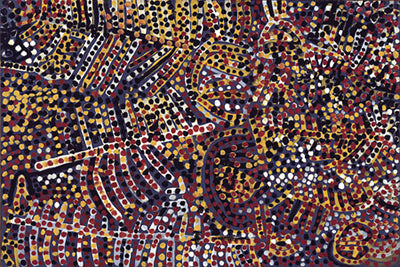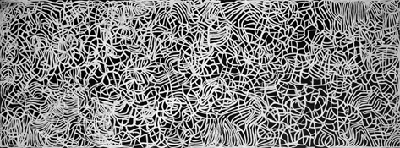Emily Kngwarreye (1910 - 1996)
View all Emily Kngwarreye's work: https://cookshillgalleries.com.au/search?type=product&q=emily+kngwarreye
Emily Kngwarreye was and will always remain one of the most successful and important contributors to contemporary Indigenous Australian art.
While Emily Kngwarreye did not start painting seriously until she was in her 70s, Kngwarreye’s talent came from a lifetime of training, first in her traditional role as a woman in her family in the Northern Territory community of Utopia, where she created designs for the various ceremonies held amongst her community.
In 1977 as part of a government-funded education program, Batik making was introduced to the women of Kngwarreye’s community, prompting the artist to found the Utopia Women’s Batik Group, within which she created designs on the provided silk that would later be considered to foreshadow her talent as a painter.
After a decade of Batik workshops in Utopia, the Central Australian Aboriginal Media Association introduced acrylic paints and canvases to the Women’s Batik Group, prompting Kngwarreye to begin painting and pioneer her own unique style, building on the simpler dotting style taught in other Indigenous communities in the early 70s. By layering not only different sizes, but also different colours of dots onto the canvas, Kngwarreye developed her initial artistic style and gained the attention of critics when her works were showed as a part of an exhibition called A Summer Project in Sydney.
As an Anmatyerre elder, Kngwarreye painted the landscapes in which she had resided her whole life with the passion and familiarity that came with a lifelong custodianship with the land. A standout piece from this collection, Emu Woman (1988-9) showcased Kngwarreye’s strong graphic innovations featuring interlinking patterns adorned with intricate dots and distinct linear structures. The busy surface represents the plants and seeds from the artist’s “dreaming”, her connection with the land, as well as mimicking the contours and designs painted onto women’s breasts for ceremonies held in homage of the Emu ancestor.
As she continued to paint, Kngwarreye’s style developed from the small, intricate dotting of her early years, to feature thicker, larger lines and splotches interweaving across the canvas or structured upon horizontal or vertical planes. Using larger brushes than previously, the artist developed a style in which she would paint vibrant patches of colour overlayed with numerous rings that she produced using a shaving brush. This was called her “dump dump” style and heralded a new phase in her work in which she produced her colourist pieces.
A continuing theme in Kngwarreye’s works was the yam tracks that held great significance not only for her personally, but for her whole community. Apart from being an important source of food for the Indigenous people of the desert, Kngwarreye’s middle name was Kame, meaning “yellow flower of the yams”, and one of her first steps in painting her later works was to create the yam lines on the canvas. A piece from the end of her career, Big Yam Dreaming (1995), a three-by-eight metre canvas, was completed in only two days and depicts the arterial pattern of the yam roots under the ground as well as the outlines of the cracked earth on the surface.
Kngwarreye was an extremely prolific painter, producing over 3000 works in the space of her eight-year artistic career.
In 2007, her piece Earth’s Creation sold for $1,056,000 at auction, setting a new record for Australian Indigenous art.



